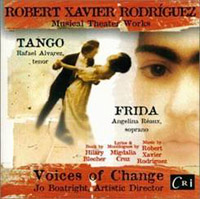Tango (1986)
Concert Opera for Tenor and Chamber Ensemble
Libretto by the composer from 1913-14 news clippings
Duration: 25 minutes
Cast: 1 Tenor
fl.cl/perc/acn.pf/vn.vc
see also Tango di Tango for orchestra or instrumental trio
Spanish translation by Josefina García available
Commissioned by Voices of Change,
The Chicago Ensemble and the 20th-Century Consort;
Grant from the National Endowment for the Arts
Premiere Performance: January 27, 1986; Voices of Change;
Paul Sperry, Tenor; RXR, Cond.
Recordings: Voices of Change, Robert Xavier Rodríguez Musical Theater Works, CRI CD824; Rafael Alvarez, Tenor; RXR, Conductor (in Spanish)
Laugh Regardless of Creed, Members of the San Diego Symphony,
Albany, TROY 740; Paul Sperry, Tenor; RXR, Conductor (in English)
Reviews:
…sizzles… comedic romp…The event drew a young, multicultural audience that was highly attentive and clearly involved in the immediacy of the music and drama…
South Florida Classical Review
Dirty Dancing at The Stage...
SouthFlorida.com
…sexy and sweaty…..a mesmerizing ode to the famous Latin dance…
Miami New Times
Rodríguez…has moved from youthful, modish dissonance to a more popular style with technical facility and stylistic assurance. His music is definitely accessible, rather what Astor Piazzola, the classically inclined Argentine tango master, might compose were he bolder about breaking the boundaries of the tango form.
John Rockwell, New York Times
…Tango presents, with both musical and verbal humor, the triumph of sensuality and frivolity over clerical pomposity. It is a light-hearted piece by a very serious composer and, as such, may well prove to be one of the treasures of our time.
Wayne Lee Gay, Ft. Worth Star-Telegram
Program Note:
 Tango (1985) is a one-act comic concert opera for tenor solo and chamber ensemble. The text was compiled by the composer from actual news clippings, letters and sermons from the height of the
tango craze (1913-14). There are three short scenes played without pause. In scene one the tenor enters as an elegant tango dancer, then quickly changes character and becomes a radio newscaster, reporting world-wide reactions to the tango, both favorable (tango teas, parties, baths and massages) and unfavorable (declared a crime in Boston and a sin in Rome). In scene two the tenor again changes character and becomes Cardinal Basilio Pompili, Vicar of Rome, as he declaims a thunderous sermon denouncing the tango in the name of Pope Pius X, but getting caught up in the tango spirit in spite of himself. In the final scene the tenor resumes his newscaster character to report attempts to reform the tango into a more respectable dance called “The Paragon,” with numerous rules for avoiding physical contact between the partners. He impersonates a dance instructor and demonstrates the paragon, but is gradually drawn back to the tango as he exits in his original character as a tango dancer.
Tango (1985) is a one-act comic concert opera for tenor solo and chamber ensemble. The text was compiled by the composer from actual news clippings, letters and sermons from the height of the
tango craze (1913-14). There are three short scenes played without pause. In scene one the tenor enters as an elegant tango dancer, then quickly changes character and becomes a radio newscaster, reporting world-wide reactions to the tango, both favorable (tango teas, parties, baths and massages) and unfavorable (declared a crime in Boston and a sin in Rome). In scene two the tenor again changes character and becomes Cardinal Basilio Pompili, Vicar of Rome, as he declaims a thunderous sermon denouncing the tango in the name of Pope Pius X, but getting caught up in the tango spirit in spite of himself. In the final scene the tenor resumes his newscaster character to report attempts to reform the tango into a more respectable dance called “The Paragon,” with numerous rules for avoiding physical contact between the partners. He impersonates a dance instructor and demonstrates the paragon, but is gradually drawn back to the tango as he exits in his original character as a tango dancer.
The score of Tango evokes the sounds of a typical cabaret ensemble of violin, piano and accordion with prominent solo passages for those instruments. Further tango atmosphere is achieved by the use of several quotations of familiar classics (Beethoven’s first Piano Concerto, Bach’s “My Heart Ever Faithful,” Schubert’s E-flat Major Piano Trio and Brahms’ Fourth Symphony) arranged in tango style. Also quoted are the medieval Mass of Tournai, which is used to represent the Vatican, and the “Minuet” from Mozart’s Don Giovanni, which is, in its original setting, used to accompany Don Giovanni’s romantic exploits in the ballroom scene, but is here employed to represent the “properly danced” paragon. As in Mozart’s opera, the minuet is accompanied by three contrasting dances: in this case three tangos, in different instrumental colors and in different meters, which gradually envelop the minuet.